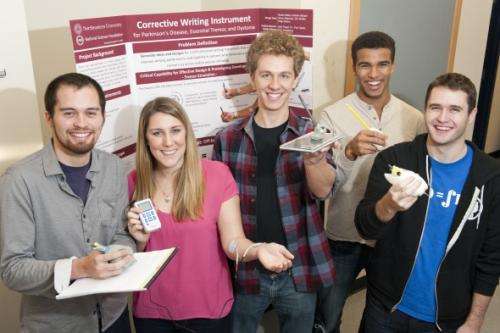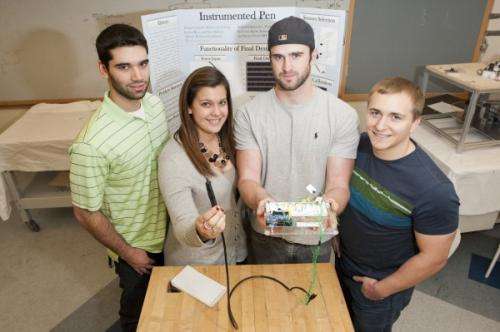Smart pens to help control hand tremors

(Phys.org)—Approximately 12 million people in the U.S. are affected by uncontrolled tremors as a result of neurological disorders such as Parkinson's disease. From buttoning a shirt to writing a note, uncontrollably shaky hands make it difficult to complete some of the most basic tasks that most of us take for granted, according to fifth-year engineering student Zac Sheffer.
His team's project to combat the problem was one of two winners in the fall semester's mechanical and industrial engineering capstone course competition. Under the direction of associate professor Andrew Gouldstone, the group came up with two approaches to improving legibility and writing performance among people with tremors.
The team's passive approach guides the hand without sensing technology, according to group member Andrew Hickson. The active approach, he said, senses the characteristics of a tremor, sends the information to a computer that calculates an appropriate response signal, and then implements the response through electrical components inside a pen.
Within these two approaches, the team designed three solutions, all of which focus on velocity-dependent motion damping. "This is key," said team member Diego Solano, "because we don't want to damp all movement, just the bit that's caused by tremors."

The student researchers needed a way to test their designs, but faced a roadblock: Patient trials were not possible because of both time and feasibility constraints. One team member, however, Mariah Dellea, recalled her experience with postsurgery physical therapy, which used electrical impulses to stimulate muscle activity.
Using a standard, over-the-counter electrical muscle stimulation—or EMS—device, the team members simulated tremors in their own hands. Then they developed a testing protocol to ensure that the simulated tremors resulted in writing performance equivalent to that of patients. They also used the protocol to compare writing performance with and without their devices.
"We needed something safe and reliable but also quantifiable and repeatable," Solano said.
With the test method in place, the students began implementing designs, focusing first on the passive systems. They developed several customized, ergonomic grips, to stabilize the hand and make holding the writing instrument much easier, said team member Darren Mahoney. At the bottom of each, they implemented a magnetic contact that interacts with a plate containing metal filings in order to steady movement.
Another of Gouldstone's capstone teams developed an instrumented pen, equipped with six force sensors that can collect information about grip tension during tremors. The data could be useful in diagnostics as well as a resource for physical therapy clinicians. This group used the other team's testing protocol to analyze the utility of their device. Using the EMS, they demonstrated that grip force during tremor increases threefold over normal conditions.
Members of both teams have several research goals for next semester. Lauren Hess and Joseph Ranieri of the instrumented-pen team will continue working in Gouldstone's lab on other projects. Members of the corrective-pen team plan to further develop their passive system and will start work on the active systems. They also hope to initiate pilot studies with patients suffering from real tremors, rather than using the EMS to simulate the disorder.
Provided by Northeastern University





















